Scientists have announced the discovery of what might possibly be the earliest known animal predator. The fossils discovered in Charnwood Forest (Leicester, England), are estimated to be around 560 million years old and the animal has been named Auroralumina attenboroughii in honour of Sir David Attenborough.
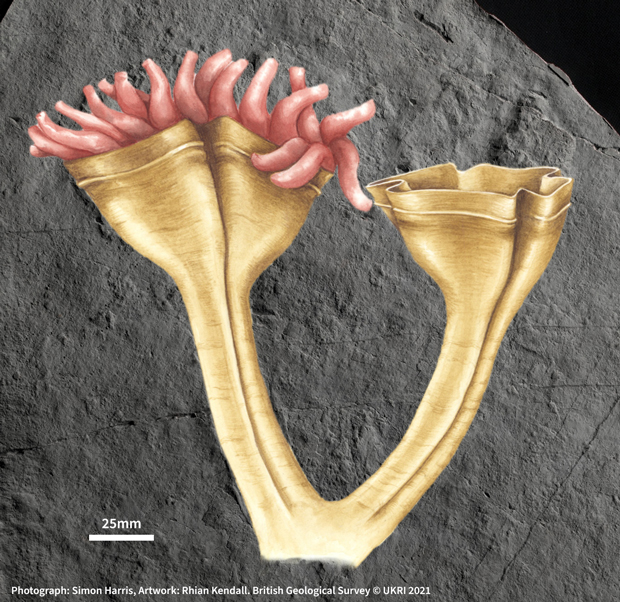
Attenborough’s Dawn Lantern
As a boy, Sir David Attenborough used to collect fossils from various locations close to his Leicestershire home. However, he never went to Charnwood Forest to hunt for fossils as the rocks exposed in that area were thought to be too old to contain signs of life.
In the late 1950s, another young boy, Roger Mason found a strange frond-like impression in a rock. Researchers identified this as the fossilised remains of a bizarre organism, later named Charnia masoni, which forms part of an ancient ecosystem that existed prior to the Cambrian.
This newly described organism Auroralumina attenboroughii honours Sir David Attenborough. The first part of its name is Latin for “dawn lantern”, in recognition of its great age and the organism’s resemblance to a burning torch.
Related to Corals, Jellyfish and Anemones
The geological period known as the Ediacaran precedes the Cambrian. The Ediacaran spans an immense amount of deep time, from approximately 635 million years ago, to the beginning of the Cambrian around 540 million years ago. In some parts of the world, notably the Mistaken Point Ecological Reserve on the south-eastern coast of Newfoundland, Namibia, Guizhou Province (China), Charnwood Forest and the Flinders Ranges of South Australia, ancient sedimentary rocks preserve the remains of the oldest, complex multi-cellular organisms known to science.
Most of the Ediacaran biota bears little resemblance to fossils associated with younger Cambrian-aged strata, A. attenboroughii is an exception, the research team postulate that the fossils represent an ancestor of today’s corals, jellyfish and anemones – the Cnidaria phylum.
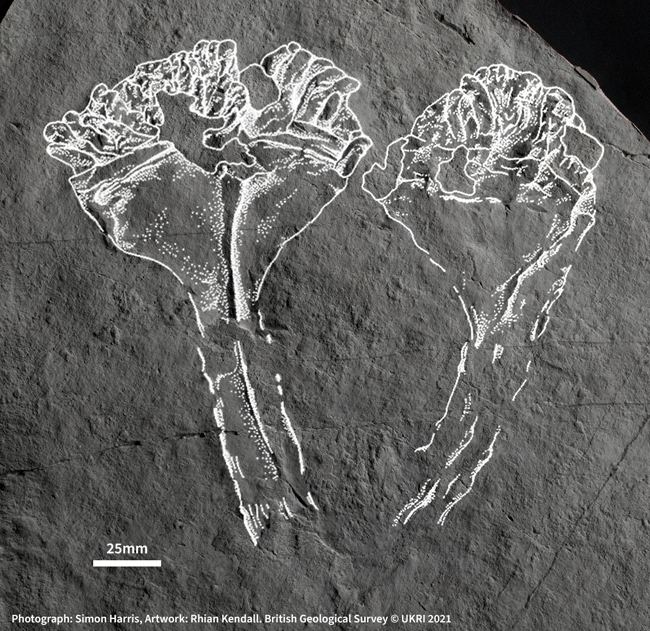
“Truly Delighted”
Naturalist, campaigner and broadcaster Sir David Attenborough stated that he was “truly delighted” with his ancient namesake.
He added:
“When I was at school in Leicester, I was an ardent fossil hunter. The rocks in which Auroralumina has now been discovered were then considered to be so ancient that they dated from long before life began on the planet. So, I never looked for fossils there.
A few years later a boy from my school found one [Roger Mason] and proved the experts wrong. He was rewarded by his name being given to his discovery. Now I have – almost – caught up with him and I am truly delighted.”
The scientific paper has been published in the journal “Nature Ecology & Evolution”. This discovery challenges perceptions as to when modern groups of animals, or their direct ancestors first evolved.
Commenting on the significance of this fossil find, one of the authors of the paper, Dr Phil Wilby (palaeontology leader at the British Geological Survey), explained:
“It’s generally held that modern animal groups like jellyfish appeared 540 million years ago in the Cambrian explosion. But this predator predates that by 20 million years. It’s the earliest creature we know of to have a skeleton. So far we’ve only found one, but it’s massively exciting to know there must be others out there, holding the key to when complex life began on Earth.”
A Geological Spring Clean
In 2007, Dr Wilby and his colleagues spent over a week carefully cleaning a 100 square metres of a rock surface exposed in the Forest. A variety of tools including pressure hoses and toothbrushes were used to spring clean deposits that were laid down at the bottom of a deep sea more than half a billion years ago.
A rubber mould of the whole surface was then taken, capturing the preserved impressions of more than a thousand fossils.
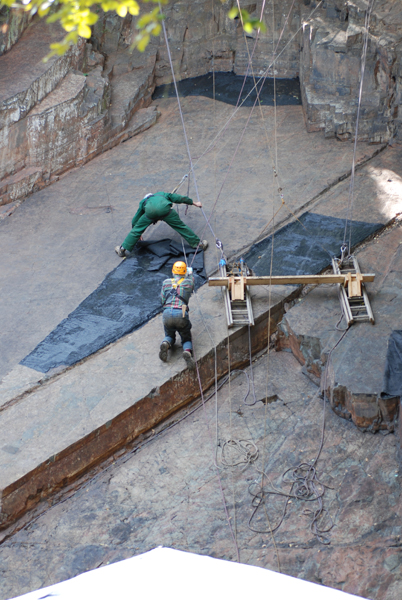
One Fossil Specimen Stood Out
Co-author of the scientific paper, Dr Frankie Dunn (Oxford University Museum of Natural History), explained that one fossil impression stood out from the rest, commenting that it looked very different from the other Ediacaran fossils (Charnia masoni and Bradgatia linfordensis) preserved on the same bedding plane.
Dr Dunn commented that Auroralumina:
“Is very different to the other fossils in Charnwood Forest and around the world. Most other fossils from this time have extinct body plans and it’s not clear how they are related to living animals. This one clearly has a skeleton, with densely-packed tentacles that would have waved around in the water capturing passing food, much like corals and sea anemones do today. It’s nothing like anything else we’ve found in the fossil record at the time.”
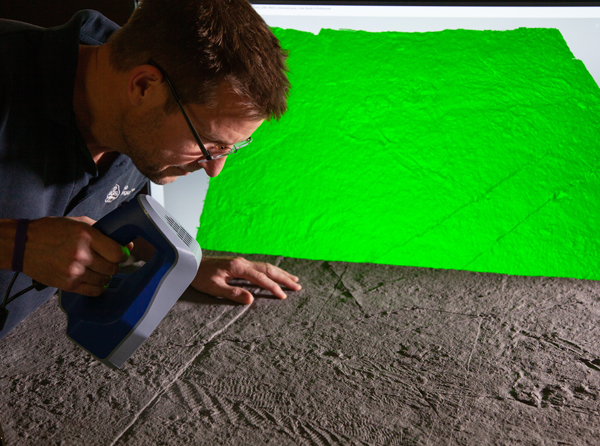
A Lonely Fossil
Dr Dunn calls the single Auroralumina specimen a “lonely little fossil” and suggest it probably inhabited much shallower marine environments compared to rest of the Charnwood Forest biota.
She added:
“The ancient rocks in Charnwood closely resemble ones deposited in the deep ocean on the flanks of volcanic islands, much like at the base of Montserrat in the Caribbean today. All of the fossils on the cleaned rock surface were anchored to the seafloor and were knocked over in the same direction by a deluge of volcanic ash sweeping down the submerged foot of the volcano, except one, A. attenboroughii. It lies at an odd angle and has lost its base, so appears to have been swept down the slope in the deluge.”
Zircon minerals associated with the volcanic deposits permitted the researchers to accurately age the fossil based on radioactive decay measurements relating to uranium/lead ratios.
Potentially the Earliest Known Animal Predator
Dr Frankie Dunn said:
“The Cambrian Explosion was remarkable. It’s known as the time when the anatomy of living animal groups was fixed for the next half a billion years. Our discovery shows that the body plan of the cnidarians was fixed at least 20 million years before this, so it’s hugely exciting and raises many more questions.”
Nonagenarian Sir David Attenborough has been honoured on numerous occasions by having newly described extinct creatures named after him. However, arguably the lonely, little Auroralumina attenboroughii may represent the most significant, as it challenges existing perceptions about when animal body plans still found today, first evolved.
Everything Dinosaur acknowledges the assistance of a media release received via email on 26th July in the compilation of this article.
Visit Everything Dinosaur’s website: Everything Dinosaur.
The scientific paper: “A crown-group cnidarian from the Ediacaran of Charnwood Forest, UK” by F. S. Dunn, C. G. Kenchington, L. A. Parry, J. W. Clark, R. S. Kendall and P. R. Wilby published in Nature Ecology & Evolution.


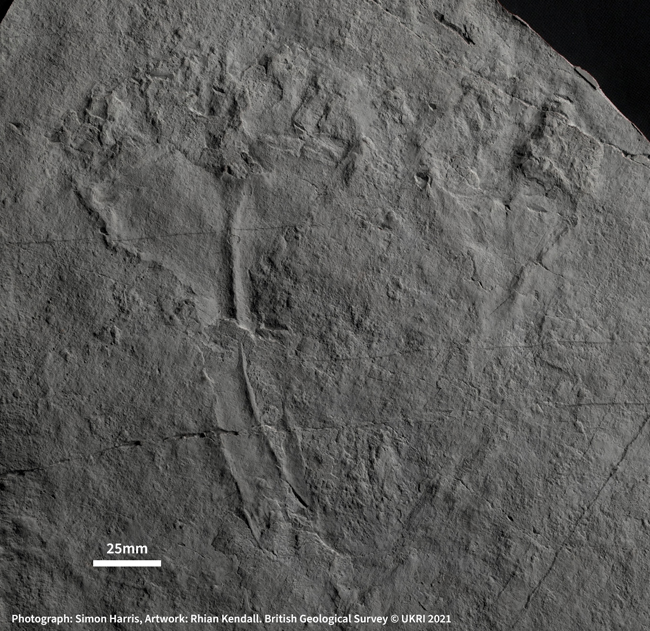




Leave A Comment